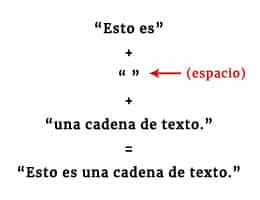 The late Latin word concatenatio came into Spanish as concatenation . The term mentions the act and result of concatenating : linking , assembling or coupling different elements .
The late Latin word concatenatio came into Spanish as concatenation . The term mentions the act and result of concatenating : linking , assembling or coupling different elements .
In the field of computing , concatenation is an operation that consists of joining two or more characters to develop a string of characters , known in English as a string . This chain is a finite and ordered sequence of elements that are part of a certain formal language. Concatenation can even be carried out by joining two strings of characters or by linking a character to another string.
Throughout the arduous and complex process involved in the development of a computer program, whether it is an application, a video game or any other kind, the concept of concatenation is used very often, since it is one of the most useful operations of the text strings, another of the fundamental elements of programming .
Although in an example out of context, such as "ab" concatenated with "ril" gives us the string "abril", it is not possible to appreciate its usefulness, concatenation has great potential in computer programming . One of the most common cases is the loading of resources, among which we have images, sounds, three-dimensional objects, libraries and the text of the user interface itself.
Each of the resource "packages" has a specific name, and can be stored in a particular folder to facilitate its organization and maintenance. Needless to say, the nomenclature , the way in which they are grouped and the methods used to access the resources arise from the decision of each developer, which is why on two given teams they can be very different.
Part of the name of a package or its directory is usually the code of the language to which it corresponds ("es" for Spanish, "en" for English, etc.), although the root is the same for all; for example: «diálogo01_es» and «diálogo01_en» refer to the same dialogue, although the first contains the Spanish version, and the second, in English.
 This is where concatenation becomes especially useful: once we take from the database the root of the name of the resource that we need to load into memory (in this case, "dialog01"), we use a function that allows us to create a new string of text by adding an underscore and the ending corresponding to the language selected by the user; Having completed this task we can now pass the full name of the resource to the load function.
This is where concatenation becomes especially useful: once we take from the database the root of the name of the resource that we need to load into memory (in this case, "dialog01"), we use a function that allows us to create a new string of text by adding an underscore and the ending corresponding to the language selected by the user; Having completed this task we can now pass the full name of the resource to the load function.
In a similar sense, the idea of concatenation is used with reference to the union of a carbon atom to other atoms of the same type to form chains , which can be cyclic, branched or linear.
Concatenation, on the other hand, is a rhetorical device that consists of repeating the final word of a verse or clause at the beginning of the next verse or clause. For example: “I admire your beautiful face / Face of a free woman / Free like the birds in the forest.” As can happen with other literary resources, it is necessary to use it with good taste and in a way that does not generate in the reader the feeling of being faced with an arbitrary repetition.
The use of the concept of concatenation in colloquial language is related to a succession , a sequence or a continuity of events or actions : "The first goal of the rival team came after a concatenation of defensive errors by our team" , "Today I will not be able to go Let's see you: I have a series of meetings planned that will not give me respite" , "Justice indicated that the series of temporary contracts is illegal" .
